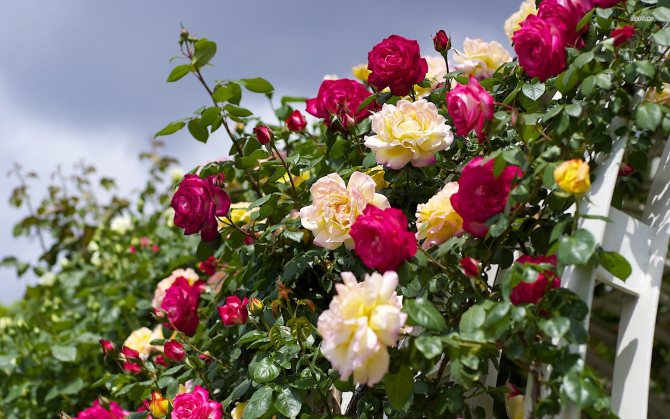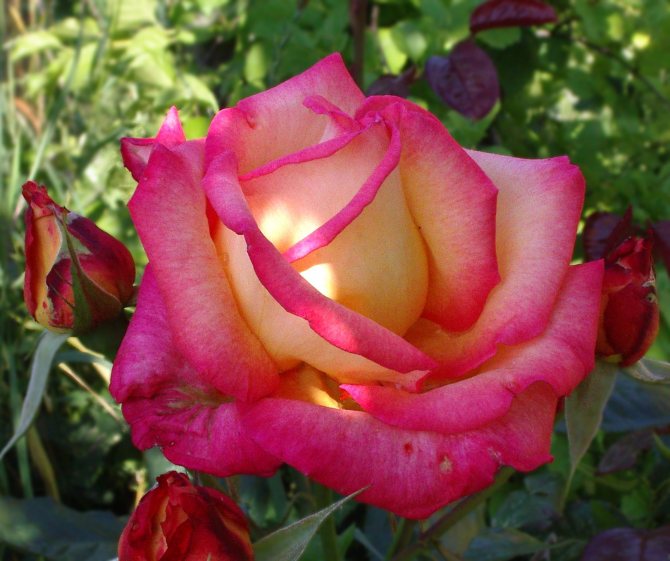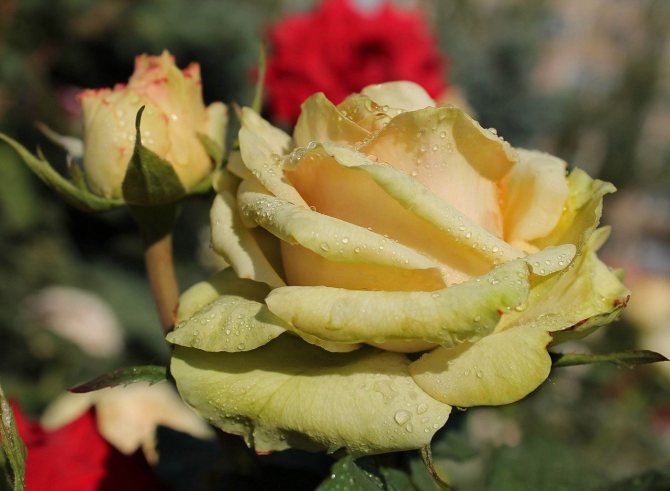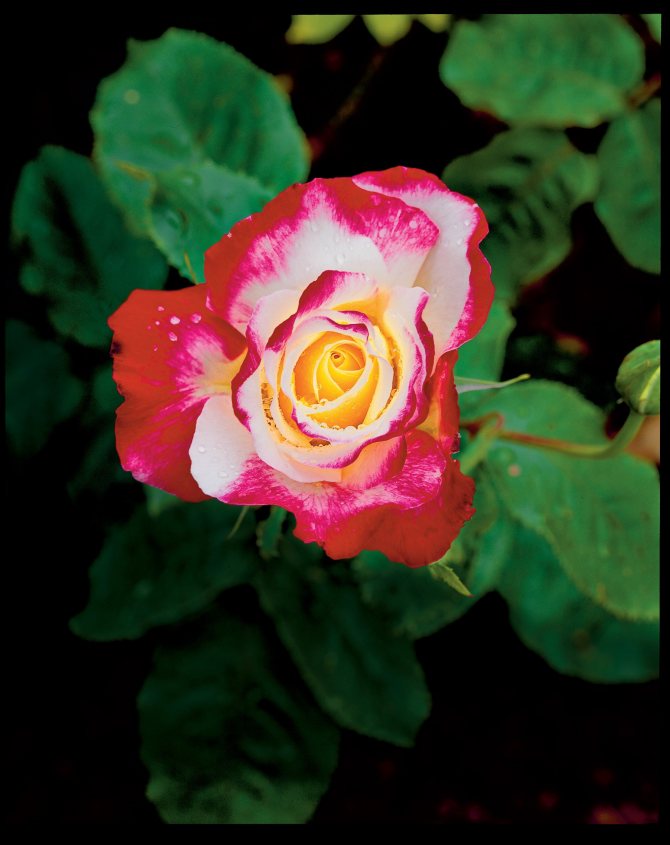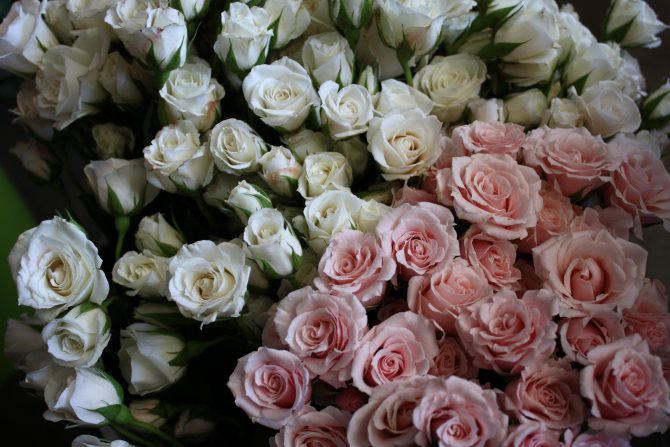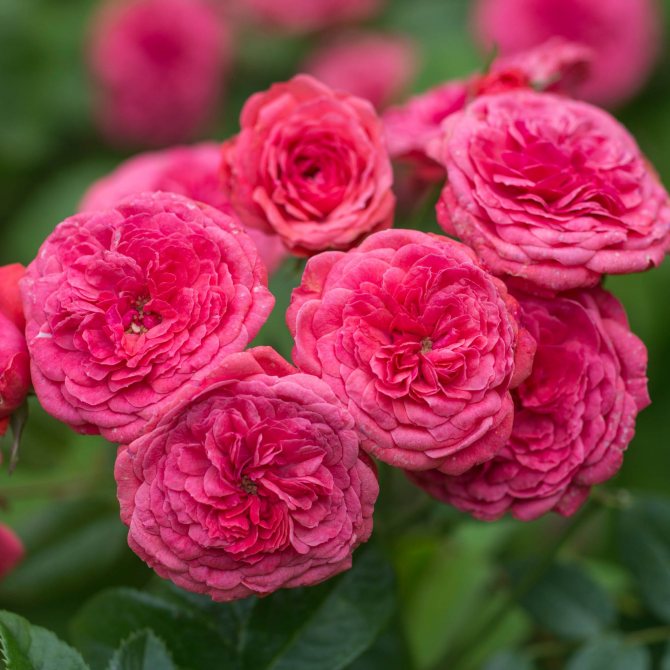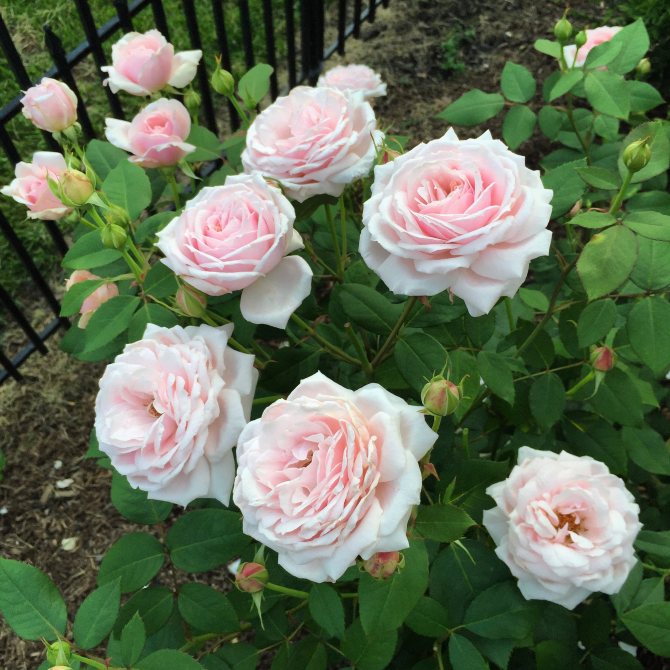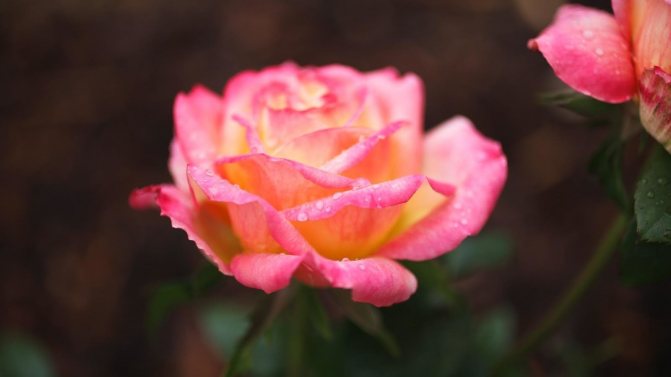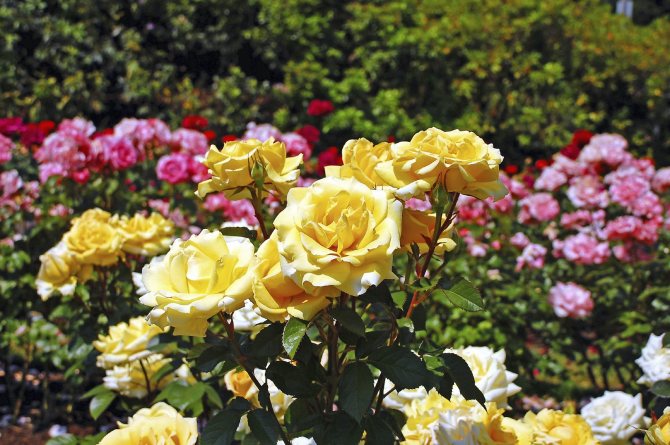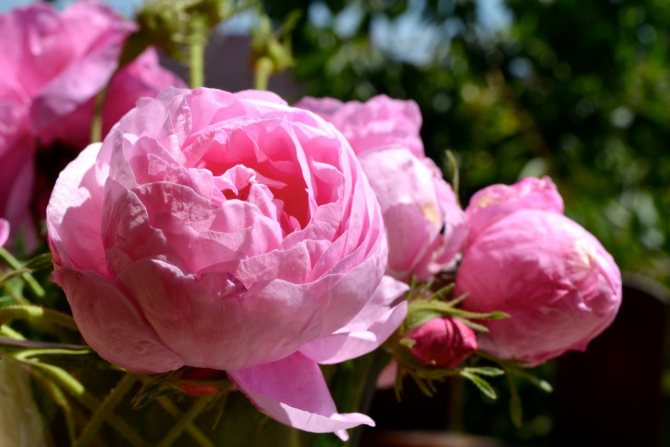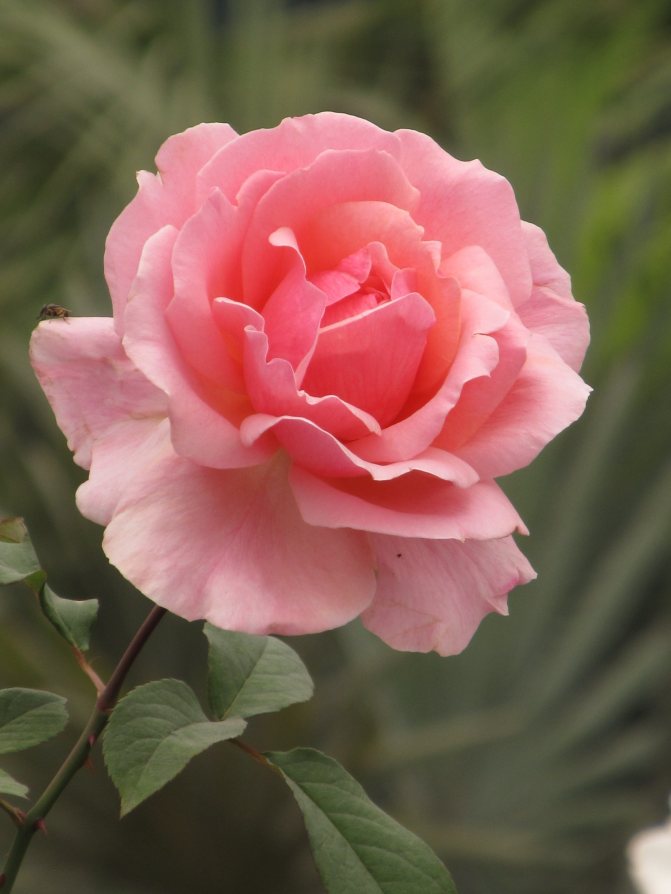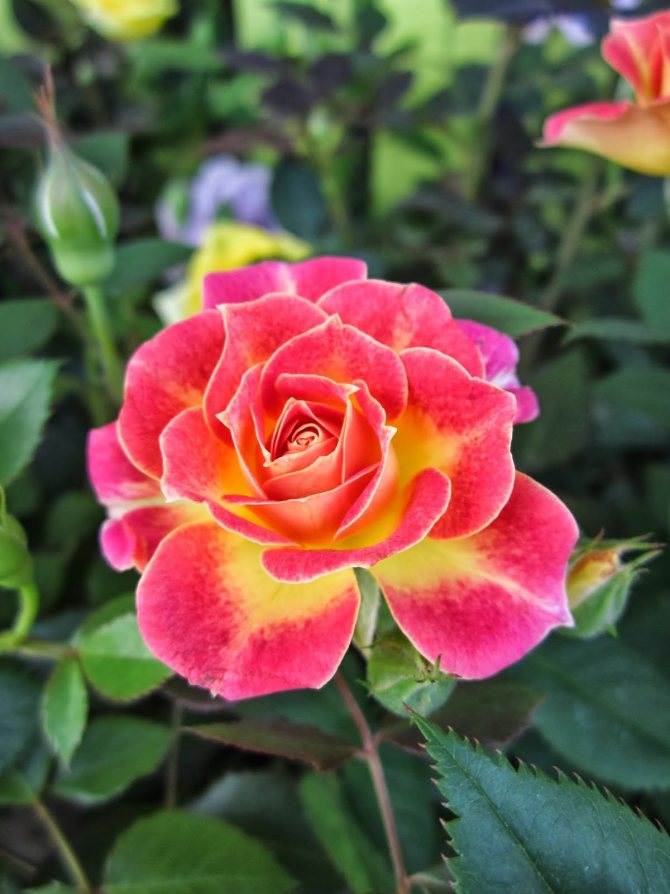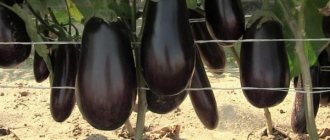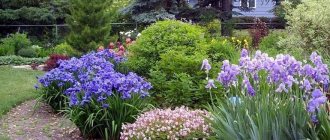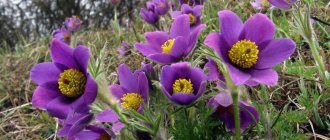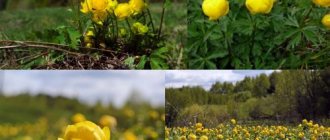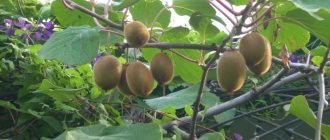It is difficult to find a person who does not know anything about roses. There is simply no more perfect flower. Florists and landscape designers prefer this plant to other flowers. Rose bushes are appreciated not only for the beauty and grace of the petals, but also for their unique aroma. The rose has long been called the queen of flowers. There is nothing to be surprised at, because only she has such a rich color palette of buds.
English roses, or as they are popularly called, Austin, were created by an ordinary farmer from England, David Austin, a little more than half a century ago. Their main differences from classic English roses are multiple flowering, original shape and color of buds, amazing aromas. Today Austin roses in landscape design are the main decoration of gardens, parks, summer cottages. Just take a look at this photo, what a beauty!

Classification of park roses
Park roses are classified according to the principle of flowering rate:
- Blooming once
- Re-blooming
Once flowering varieties are categorically impossible to cut off, because they can bloom only on last year's shoots. However, this is their advantage: the branches do not require bending, they winter well without shelter. This is a group of vintage roses that are cultivated rose hips. Among them, the most common varieties are Wasagaming, Minette, Poppius.
Re-blooming park roses, in turn, are further subdivided into subgroups:
- Frost-resistant hybrids, rugoses
- Frost resistant canadian park roseswintering without shelter subject to agricultural technology
- A group that does not hibernate without shelter, and requires bending of branches
Rugoses delight with their frost resistance, however, they cannot boast of a variety of shapes and colors, remotely resembling each other. Some hybrids are beautiful, but require shelter for the winter.
Loading ...
The Canadian rose group has gained particular popularity, the most prominent representatives being the Morden Centennial and Prairie Joy varieties.
Among the covering varieties, there is a huge variety of shapes and colors. One cannot fail to note the work of the English breeder David Austin, who presented the world with the Fisherman's Friend variety of covering park roses, enchanting with its unique beauty. Popular varieties of work of breeders Meiyana, Cordes, Tantau. This group also includes old remontant and Bourbon varieties.


Climbing roses in garden decor
David Austin created not only bush, but climbing varieties of English roses. The value of climbing varieties in endless flowering. The buds are located along the entire length of the lash. The English breeder currently has more than 20 varieties. Three years after planting a rose bush, the whip is already about three meters. You can experiment with climbing roses, creating unique landscape compositions.
Even experienced flower growers are surprised to see such a rose bush as in the photo.
This line of rose bushes has not passed by queen garden lovers and landscape designers. Bright, double flowers against the background of juicy green leaves can decorate any corner of the garden or park.
Curly roses decorate fences, benches in the garden, statues, fences, create airy gazebos.
Advice! Care must be taken to ensure that the support for climbing English roses is reliable.
Rose bushes blend harmoniously into any landscape. In confirmation - photos, which show options for decorating various fences, including old nondescript fences.
English roses in facade design
If the roses of David Austin are planted next to the house, then most often they choose a place near the front door or windows. The whips need to be positioned in a certain direction so that they can braid on the supports. Flexible stems, the length of which is from 1.5 to 3 meters, are taken up along the supports around the window, they are even taken up to the roof of the house.
Throughout the warm season, the owners enjoy the amazing aromas of Ostins, the variety of which the venerable perfume creators envy:
- fruit;
- aroma of old roses;
- myrrh;
- combination of aroma of tea roses and musk.
Attention! At different times of the day and depending on the temperature and humidity of the air, the aromas change: sometimes delicate, barely perceptible, then tart.
And how festive a house looks, the wall or windows of which are entwined with ostinks. We suggest that you familiarize yourself with some of the works of landscape designers presented in the photo.
English varieties of park rose
Among the English varieties, the best are:
- Abraham Darby. The variety is fast growing, strong, disease resistant. It blooms twice per season with classic large flowers in the form of a bowl. The flowers are copper-apricot in color, pink at the edges, with a charming scent.
- Benjamin Britten. Rose bushes are very powerful, only a meter high. The plant blooms profusely, has large red flowers with a fruity aroma. It blooms twice, which allows this variety to be used for decorative purposes.
- William Shakespeare. The variety was bred in 2000. It is very popular with gardeners, as it is resistant to diseases, temperature changes. The plant blooms all season. Velvety red flowers are formed on each shoot, last more than two weeks. The bushes of this variety look luxurious, and with proper feeding they bloom very densely. Not susceptible to disease.
Why do designers choose Austinki
When creating landscape design, flower growers give more preference to varieties created by David Austin. Why so much interest? Let's try to figure it out:
- richness of colors and grace of the shape of the bud;
- abundant and prolonged flowering, some varieties have three waves;
- persistent peculiar aroma of apple, kiwi, musk, almond, honey.
- high vitality of rose bushes - they can withstand temperatures of -35 degrees;
- many rose diseases and pests are not terrible for English roses;
- Ostinka is not capricious in leaving, unlike other types of roses.
The only difficulty is that having taken English roses as the main material for landscape design, you will have to seriously deal with the choice of a place for planting.
A warning! Direct sunlight negatively affects the condition of the English beauty.
Canadian park rose varieties
Canadian park rose varieties include:
- John Davis. It is the best variety for growing in the Moscow region. It can bloom until the first frost. The bushes of this variety are large, grow up to two meters in height and width, which must be taken into account when planting. The flowers are light pink, collected in a brush of 15 pieces, very fragrant. Disease resistant variety.
- John Franklin. A beautiful rose of bright red color with a light aroma. It blooms with single flowers and small inflorescences. This variety has neat bushes no more than one meter wide. Roses John Franklin are resistant to severe drought, sun, disease resistant.
- Morden Sunrice. Bush up to a meter in height, up to 65 cm in width. Frost-resistant variety, blooms twice in summer. The flowers are large, bright orange.
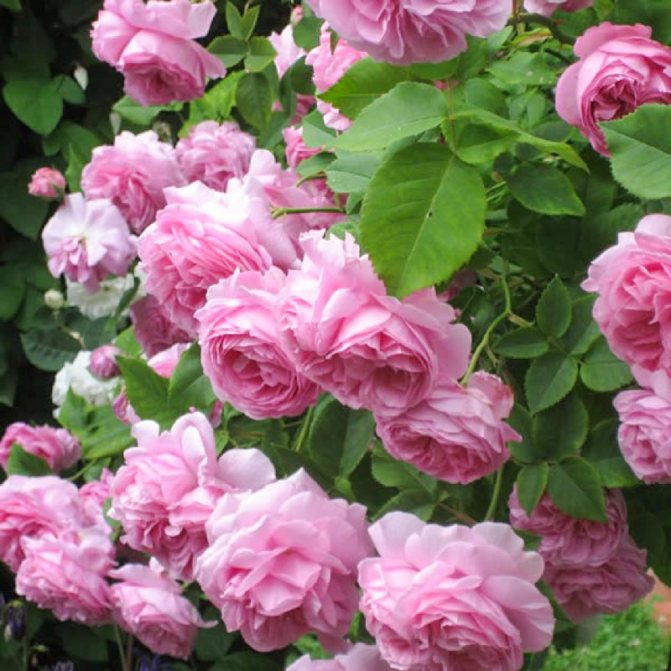

Review of the best varieties of roses for the Moscow region
When choosing any kind of roses for the Moscow region, many characteristics should be taken into account. Since this region is located in the Middle Lane, and the climate can vary greatly throughout the year, it is necessary to take into account such features as resistance to cold and sudden changes in temperature. It is the endurance of flowers that plays a very important role for every summer resident.At the same time, preference is given to those varieties that combine not only these factors, but a unique aroma and beauty.
It should be said right away that the flowers that were bred for cultivation in the Middle Lane take root very well in the climate of the Moscow region. This is confirmed by specialists from the Topalovich brothers' nursery. They very carefully researched varieties of winter-hardy roses for the Moscow region and came to the conclusion that they can easily endure the winter even without shelter.
Basically, preference is given to Canadian and English roses, most of the flowers of the German family Kordes (Kordes). For the Moscow region, it is also recommended to choose some plant species from the Tantau, Olesen, Meilland, Delbard families. What are the best varieties of roses for the Moscow region that hold the leadership palm? What exactly do summer residents like? What features do these flowers have?
The best roses: varieties for the Moscow region (description, photo)
According to numerous reviews and data from surveys, a group of roses was identified that can most often be seen in flower beds in the Moscow region. Most varieties combine all the preferences of local summer residents - beautiful, fragrant, not afraid of frost and resistant to climate change.
The best varieties of roses for the Moscow region:
- Amadeus (Amadeus). A very attractive and aromatic climbing variety, which is most often chosen to decorate building or garden elements (arches, walls, fences, arches). Semi-double, saturated, medium-sized red flowers are collected in clusters of several pieces. The bush is quite sprawling. On its shoots, which grow up to 3.5 m, there are a lot of branches, which are abundantly covered with flowers. Sometimes all the stems are completely hidden under a solid blanket of flowers. The peculiarity of Amadeus is that the shoots develop quite rapidly. The first flowers appear in early spring. For the continuity of flowering, many choose this particular variety of roses for the Moscow region. Almost all growers want to buy it.
- Florentine (Florentina). A very attractive neat ornamental plant, which is used both for the formation of bouquets and for landscape design. Its erect stems can reach a height of up to 2 m. When forming a bush, you can make the necessary pruning, then it becomes very lush. Florentina's flowers are red, collected in bunches. The diameter of each elongated bud can reach 10 cm. The flowers tolerate winter very well. They belong to unpretentious, non-covering varieties of roses (for the Moscow region this is a very good property).
- Gloria Dei (Gloria Dei). Belongs to the selection of Meilland. It attracts with its unforgettable appearance and light, almost imperceptible aroma. Its double, two-colored buds with smooth transitions (from gently rosy to light yellow with a characteristic crimson edging at the tips of the petals). This variety of hybrid tea roses for the Moscow region is an ideal option. In terms of beauty, he also takes first place. This opinion is shared by many people around the world.
- Jubile du Prince de Monaco (Jubilee of the Prince of Monaco). These flowers belong to the breeding developments of the Meilland nursery. The peculiarity of this variety of roses (floribunda) for the Moscow region is that over the entire flowering period, the color of the buds changes from a white shade with a red edging of petals to a rich red tone. During the flowering period, the buds become light green or green. The petals themselves are wavy. There are about 35 of them in one large flower. The buds of Jubile du Prince de Monaco practically do not emit aroma, but ripe flowers during their peak of growth smell of a light caramel aroma.
- Rhapsody in Blue These are wonderful roses shrabs for the Moscow region. Introduced them in 2002 by the Cowlishaw Rose Garden. They attract attention by the fact that the neat bush blooms very profusely, and the unusual shape of purple flowers with a light center bewitches with an indescribable look. This is a fairly popular variety of roses for the Moscow region.
- Super Dorothy (Super Dorothy).Thanks for these beautiful flowers should be given to the German nursery Hetzel. Intensely pink flowers that look like an expensive ball gown attract with their tenderness. Super Dorothy blooms profusely, twice a season. The break between flowering is practically not noticed. Super Dorothy is rightfully classified in the category of the best varieties of roses for the Moscow region. Reviews of experienced florists and summer residents testify to this.
- Pierre de Ronsard (Pierre de Ronsard, Eden Rose). The French are very careful in breeding the best varieties of roses, unique in shape and beauty. There are a lot of climbing roses for the Moscow region, but Pierre de Ronsard is one of the most beloved. A remarkable property of the plant is thornless shoots. The flowers are light cream. The central petals have a deep pink hue. The shape is neat, goblet. The aroma is light, not saturated. They look very good in the interior of arbours, gazebos, house canopies.
It should be noted that this is a very short list. It is necessary to include in the group of the best flowers for the Moscow region and Austin roses, hybrid tea, ground cover, climbing, park. Canadian park varieties of roses that are resistant to harsh climatic conditions are also especially popular. For the Moscow region, this is an ideal option.
Among the wide assortment, novice summer residents and flower growers often cannot choose the most suitable plant species. What varieties of roses are best to plant in the Moscow region?
Roses for the Moscow region. The best varieties
The criteria for choosing a prickly beauty for your flower bed are purely individual. But besides personal preferences, the summer resident should always pay attention to the versatility of the plant and its relevance to local climatic conditions. There is no clear distinction between good and bad varieties. All summer residents want to grow beautiful, abundantly blooming all summer and autumn, unpretentious, frost-resistant varieties of roses. For the Moscow region (even more so without shelter for the winter), not all flowers are suitable. Therefore, it is better to give preference to the popular known species of this plant.
Climbing roses: varieties of constant flowering for the Moscow region (you can buy seedlings in the online store):
Cordes
- Flammentanz.
- Yasmina (Jasmina).
- Raubritter.
- Rosarium Uetersen.
Rambler
- Bobby James.
- Snow Gooz.
- Rembling Rektor.
Climing
- Gloriya de Klaiming.
- Golden Parfum.
- Rimosa.
Park roses, varieties for the Moscow region:
- Luiz Oder, France.
- Preiri Joy, Canadian.
- Fishermend Friend, England.
- L. D. Breitweit, England.
The best varieties of floribunda roses for the Moscow region:
- Leonardo da Vinci
- Marytheresia (Mariatheresia).
- Pomponella.
- Tchaikovsky (Tchaikovcki).
The best varieties of Canadian roses for the Moscow region:
- Morden Centennial (Modern Centennial).
- Adelaida Hudless.
- Alexander Mackenzie (A. Mackenzie).
- Wasagaming.
The best varieties of hybrid tea roses for the Moscow region:
- Parole
- Apfrodita (Aphrodite).
- Ingrid Bergma (Ingrid Bergma).
- Hommage a Barbara
The best varieties of ground cover roses for the Moscow region:
- Hello (Hello).
- Sunny Rose (Sunny Rose).
The best varieties of Austin roses for the Moscow region:
- Mary Rose (Mary Rose).
- Crocus Rose
- James Galway
Thanks to such a wide range of these beautiful flowers, every summer resident can choose exactly the one that will meet all his requirements and preferences.
www.glavnaya-
Planting park roses in open ground
In order for roses to bloom for a long time and abundantly, they need to pick up a sunny area protected from the wind with fertile, breathable soil. Do not plant them in the shade under tall trees, as they will not bloom abundantly.
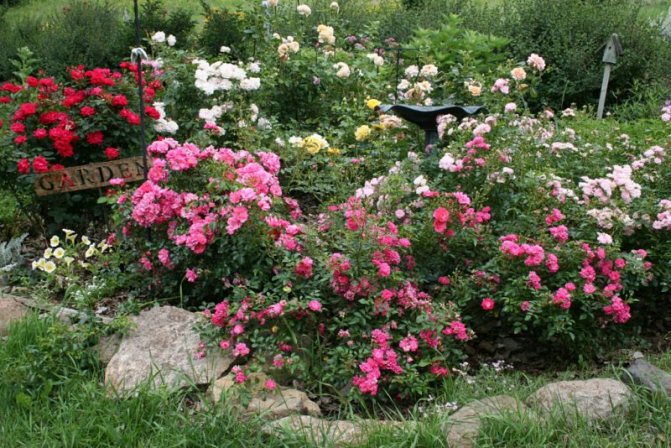

Roses can grow in any soil, but they still prefer light clay soil with a lot of humus. If the clay soil is too heavy, it can be improved by adding peat or rotted manure.
It is best to plant park roses in the fall - from mid-September to frost, so that the plants have time to take root. Then in the spring they will quickly start growing with renewed vigor.
Since park roses grow strongly in breadth, it is initially better to plant them at a respectful distance from each other. This is also necessary so that the bushes are convenient to handle and cover in the cold season.
Landing technology is not complicated at all. Dig a hole, add compost and bone meal mixed with earth to it. At the bottom, form a mound and carefully place the seedling so that the roots descend. After that, cover with earth so that the root collar is 2-3 cm below the soil level. It remains to compact the soil, water and mulch the earth. When planting in autumn, the seedlings are spud up, preparing for frost.
Create a secluded corner
David Austin's English roses are a lush spherical bush. Landscape designers find them a variety of uses, planting them in the most secluded corners of a garden or park. The shape is created by pruning the rose bush.
Luxurious places for rest and relaxation are one of the landscape design options. Climbing varieties of ostinks can be placed on wooden, metal trellises or made of thick wire, around garden benches, arbors.
Shrub and standard Ostinka varieties are planted in front of the trees; against the background of green foliage, rose bushes acquire an advantageous position.
Don't you want to retire by sitting in silence on a bench in a gazebo. Landscape design options in the photo below.
Arches and arched enfilades
From curly ostins you can get amazingly beautiful arches and enfilades. You just need to find a place where they will compete favorably with other plantings of the garden, and make arched supports. They must be resilient. Rose bushes are planted under the supports. To prevent the lashes from falling, gardeners wrap flexible branches around the base.
Among David Austin's recent masterpieces is the Claire Austin rose, named after the breeder's daughter. The color of the closed buds is soft lemon, and when the flower opens in all its glory, it is dazzlingly snow-white. After a few days, the bud turns pink-beige.
Attention! The Claire Austin variety in the first two years is bushy, but then the whips grow up to 2.5 meters, it becomes climbing.
Therefore, the rose bush must be planted near the trellis. Imagine an arch, which during flowering is covered from top to bottom with buds of different shades. Isn't it a miracle !?
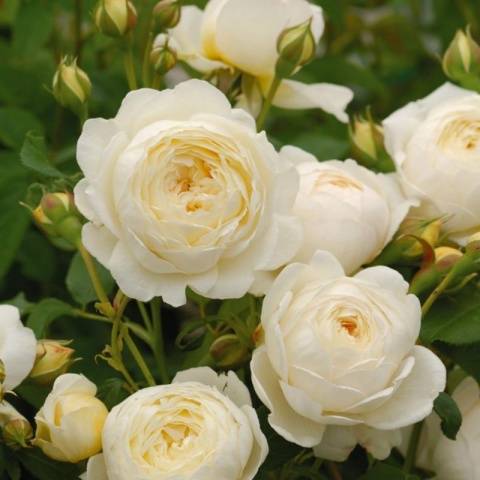

Rose Claire Austin in Landscaping.
Flower care and cultivation


In order for roses to please the owner with flowering for many years, you should know some of the nuances regarding care:
- In the first three years, it is imperative to regularly loosen the ground around the bushes, feed 3-4 times per season, fertilize with manure in the fall. During this period, the formation of the root system and the skeleton of the branches occurs.
- It is useful to periodically fertilize plants with ash infusion.
- Watering should be abundant, but not frequent. The main thing is that the water penetrates well inside, to the roots.
- Avoid pruning sturdy shoots in late summer and autumn. So the roses will survive the winter better.
- Hilling should be carried out before the onset of stable cold weather to a height of 20 cm. Cut off young branches. Then the plant should be wrapped with lutrasil, and a little later covered with spruce branches.
If there is a thaw in winter and the temperature rises above -8 degrees, open the shelter a little for ventilation. If this is not done, mold may develop. In the spring, you need to remove the shelter in time to prevent overheating.


How to combine with other colors
David Austin's English roses are good on their own, but in landscaping they are often combined with various garden plants. Such a neighborhood will not interfere with them, on the contrary, it will reveal the perfection of the queen of flowers to the fullest.
As already mentioned, rose bushes do not like the scorching sun. You can plant next to them:
- tall grasses;
- cereal plants;
- bulbous and non-flowering garden plants.
When creating a mixborder, the bottom rows are filled with:
- irises or ageratum;
- cuff or geraniums;
- purslane or bells.
The middle tier is given to daffodils, tulips, gladioli. Clematis, primroses, herbal carnations will look good next to rose bushes. Look carefully, perhaps some photos will give an impetus to your imagination, and you will create a unique version of landscape design.
Not only vertical or horizontal gardening is widely used in landscape design, the ostinki can be planted in flowerpots. This design is called mobile: the pots are easy to move to a new place. Most often, roses with small flowers are used.


Video about English roses:
Useful tips for growing a park rose
- If you water the rose bushes in small doses, the root system will grow chaotically. The roots will be located near the surface of the earth, which contributes to freezing.
- The deep bedding of the roots leads to a better development of the bush. The life span of the bush, resistance to negative temperatures directly depends on this.
- At the end of summer, when there is enough rainfall, watering should be reduced. Stop completely in the fall, otherwise the bushes will begin to give young growth. She will not have time to get stronger before frost and will die.
- In regions where dry weather prevails, when planting park rose seedlings, a hydrogel is added to the planting holes. It helps to maintain the optimal amount of moisture.
- Pruning park roses in the first three years is not rational.
- Young shoots are pruned by 5-7 cm at the end of summer. This procedure will make it easier to get through the winter, it contributes to the formation of stronger shoots.
- It is necessary to organize a shelter for the winter for young seedlings. They should be spud and wrapped in 2-3 layers of non-woven material. This will help protect the bushes from bright winter light, strong winds, and temperature extremes.
- Adult park rose bushes, which cannot boast of frost resistance, need to spud and cover with foil in late autumn. The optimum temperature for shelter is +5 degrees.
For novice flower growers, park roses can seem difficult to grow. In fact, this is not the case. It is not difficult to grow beautiful park roses, planting and caring for which does not require much effort. With proper care, top dressing, competent watering, a park rose will delight you with an abundance of charming fragrant flowers for 25 years.


Ostinok application options
In English varieties, the shape of the bush is spherical. Stems and branches from the very bottom to the top are strewn with buds. The color palette of the ostins is varied, even the most fastidious gardeners will be able to choose a rose bush for themselves.
When creating landscaping, every part of the plant is important. Ostinks come with drooping or erect branches. Both are valuable for creating flower arrangements.
With the help of English roses, you can create a rose garden, decorate mixborders, they are often used as tapeworms due to their high vitality.
Photo of Austin in a mixborder. Pink buds do not overwhelm the flowers surrounding the bush, on the contrary, they enhance their uniqueness.


The Ostinki, planted along the garden paths, share their multicolored work area and recreation area. Landscape designers especially appreciate the William Shakespeare 2000 variety. It is good both for single plantings and in combination with other roses or flowers on lawns or garden paths. Is it possible to pass by such beauty with an indifferent look?
Landscaping options for paths in the private courtyard are presented in the photo.


7
David Austin's roses are unpretentious, flowering is often three-wave. The presence of English roses in rockeries, roller coasters, in single or group plantings, in the form of a standard tree will make any garden irresistible.
Stamp ostinki
David Austin used the upright varieties Pilgrim and Port Sunline to create the standard form of the rose bushes. The picturesqueness of the standard ostins will add romance and elegance to your garden: there is one trunk, and a whole bunch of flowers! Flemish women will live with you for a long time, you just need to learn the rules of care.Here are several varieties of standard ostins:
- Schuss
- Lady Emma Hamilton.


- Swanee
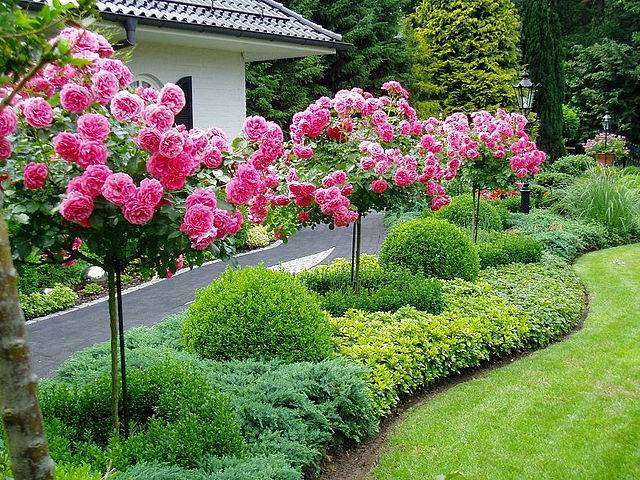

- Mary rose
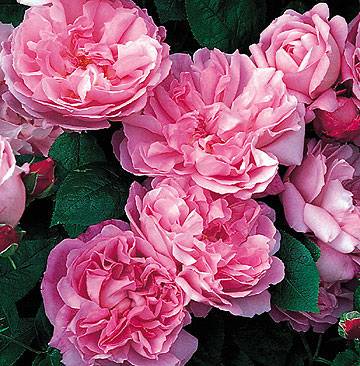

Pruning and covering park roses for the winter
A park rose is cut minimally, cutting out only old, damaged or frozen branches. After flowering, the faded buds are cut off. Pruning is completely stopped in August. In autumn, the branches are freed from the leaves, bent down, pinned with metal staples and covered. Especially powerful bushes are difficult to bend to the ground, then you will need to dig them up on one side until the root begins to bend and tilt the bush. The root collar must be earthed to a height of 20-30 cm. The rose is covered with spruce branches from above, non-woven material can be used. The main condition is that the shelter breathes, and the branches do not come out in wet, damp weather.
In the spring, when the snow melts, the structure is dismantled, straightening the bush before the start of sap flow. Old 4-5-year-old branches are cut at the root. It is advisable to process the cut points with garden pitch so that the rose does not get sick. Young branches are not cut. The remaining branches can be cut into two buds so that the shoots on them are more powerful. Make sure that when pruning, all the upper buds look outward of the bush, and not inward.
Landscaping - ground cover roses
David Austin's extensive collection also includes ground cover roses that can be used to decorate pergolas, gazebos, and create hedges. Flower beds with rose bushes look no less attractive, the whips of which are spread out on the ground and spread their flowers along their entire length.
Standard and climbing roses can be used as carpet, if you give them a weeping shape of lashes.
Attention! Ground cover roses are important not only for creating various landscape design options for a garden, park. They prevent rainfall and winds from destroying the soil layer.
Carpet or ground cover varieties of roses when creating landscape design are planted both singly and in whole groups. Look at the photo how you can use such rose bushes when decorating a site.
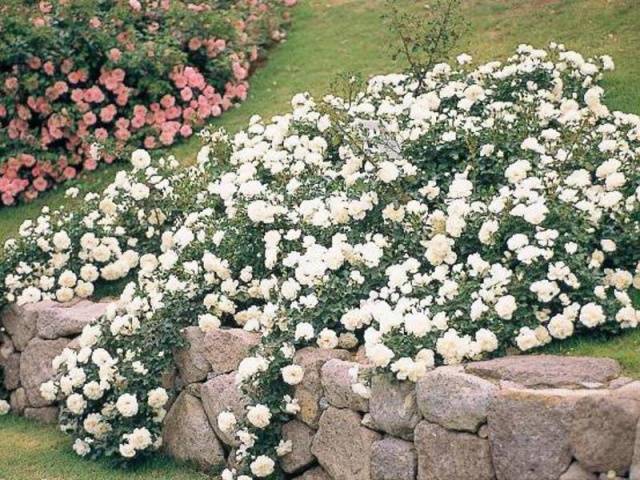

Reproduction by root suckers
Root suckers grow from the mother bush annually. They appear on the surface in the form of shoots. A year later, such shoots already acquire their own roots. For reproduction, you need to choose one-year-old root suckers, remove the soil, cut the root. Can be planted in a permanent place.
It should be remembered that you can only take the offspring that grows at a distance of a meter from the mother bush. Then its root system is minimally injured.
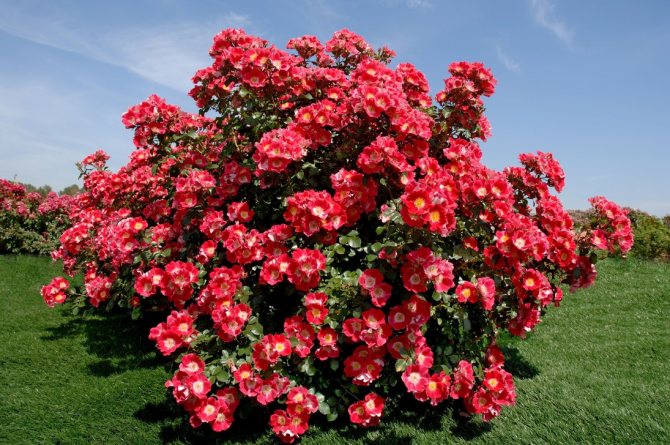

Choosing a site for planting
Before you start planting a plant, you should decide on a place. For this culture, a well-lit area with the sun is more suitable, which will be well ventilated from each side. However, it is possible to place the future bush in partial shade - this is not critical. When planting a rose, you need to take into account the composition of the soil.
For park varieties, soil is suitable:
- contains many nutrients;
- loose in structure;
- easy;
- characterized by a high presence of humus in the composition with a total acidity of pH 6-7.
Loam most of all corresponds to such characteristics. If the planting is carried out in sandy soil, then it will be necessary to add fertilizers corresponding to the composition.
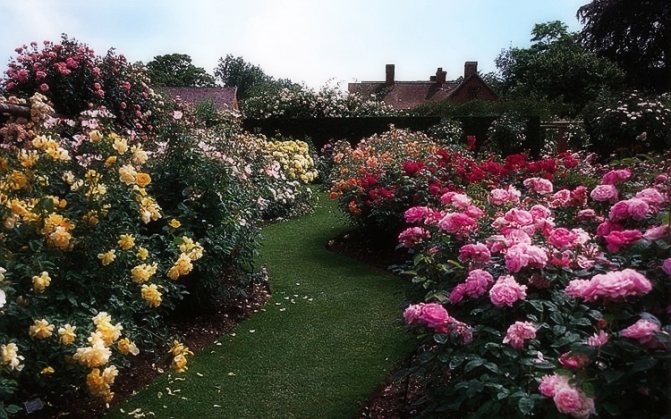

Prevention of diseases and pests
Park roses sometimes suffer from powdery mildew and spheroteca. If you do not take action, plants may even die. For prophylaxis, in the spring, before the beginning of the growing season, all the bushes are sprayed with a solution of ferrous sulfate, and during flowering - with modern drugs.


The most common pests are weevils, aphids, spider mites and leaf rollers. They damage buds, leaves, buds, flowers. In order to prevent the appearance of pests, the bushes should be fed on time and correctly, the soil should be loosened regularly, and weeds should be removed. When watering, try to water only the area near the trunk to avoid excessive moisture.In the event of an invasion of intruders, spray the plants with Vermitek, Aktofit or Fitoverm.
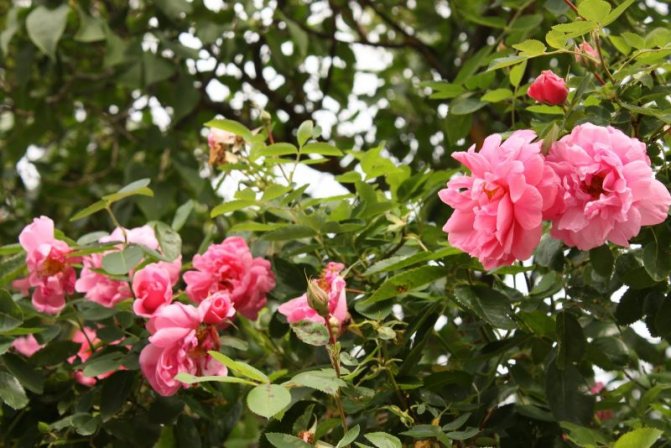

Proper care of roses and timely prevention reduces the likelihood of pests to a minimum.


Roses in flower beds
English bush roses are an important element for the design of flower beds. The uniqueness of the ostins is that the flowering lasts a long time, the buds with double centers attract the eyes, they never get sloppy.
Attention! Varietal variety allows you to create any "ornaments", if you add flowers to the flower beds, combined with roses.
Features of flowering and pruning
Plant pruning should be carried out in accordance with the rules for the formation of an ornamental culture and in a timely manner. The main pruning is carried out in the spring and consists in removing dead branches and thinning part of the shoots in order to stimulate flowering. Cut the stems at a 45 ° angle using a sharp, clean pruner. Diseased shoots are cut to a healthy area, and the branches to be thinned should be cut 5-6 mm above the bud. On grafted roses, it may be necessary to periodically remove wild root growth to ground level.
Tips for beginner gardeners
The most favorable period for planting roses is the second half of September-early October. Weather conditions at this time are most suitable for plant adaptation. In autumn, the soil has not yet cooled from the summer heat, and there is enough precipitation, which contributes to better rooting of seedlings in comparison with spring planting.
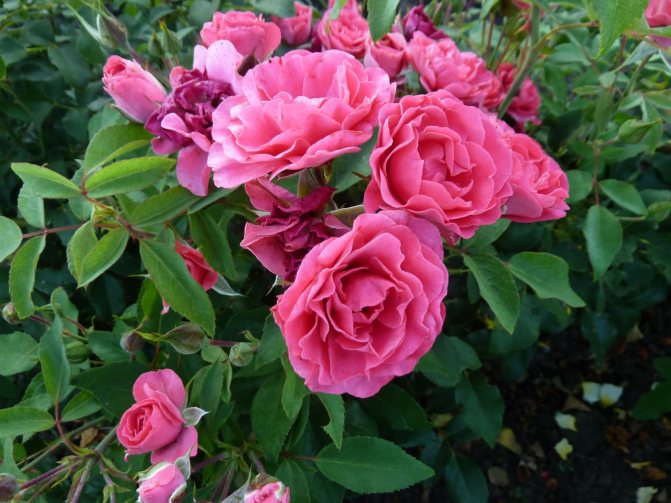

Park rose
In spring, roses can also be planted, but this should be done when the ground is warmed up to a temperature of 10 ° C.
What are the zones?
4 zones of winter hardiness - what is it? The winter hardiness zone is the climatic zone of the Earth where this or that plant can grow. They are based on average annual temperature indicators. Also indicate the minimum temperature values in certain areas. The most complete temperature scale in use today is called the USDA.
Russia is no exception, and is also divided into climatic zones. Some large cities belong to the following frost resistance indicators:
- Zone 1 - Batagay, Tiksi.
- Zone 2 - the main territory of the country, Novosibirsk, Krasnoyarsk, Yakutsk.
- Zone 3 - Magadan, Vorkuta.
- Zone 4 - Moscow, Moscow region, Ufa, Chelyabinsk.
- Zone 5 - St. Petersburg, Voronezh, Bryansk, Saratov.
- Zone 6.7 - Krasnodar.
Thus, nursery roses should be chosen adapted for zones 1-4 and partially 5.
And we wrote about the best varieties for Siberia, the Urals and central Russia here.
What plants are unpretentious?
The current range of roses is about 15,000 varieties. They all differ in:


color;- size;
- form;
- smell.
There are about 60 plant species in our country. But frost-resistant varieties of flowers that can grow and winter in a harsh climate require special attention. Their total number is difficult to determine, because every year breeders breed all new types of roses that could survive at a temperature of -40 ° C.
Why are roses pruned?
Roses grow well in warm climates. They prefer heat over frost, so for the winter the plants are carefully covered and protected from the cold.
Overgrown bushes with many shoots are difficult to neatly hide under the film. In addition, their branches intertwine, interfering with air exchange. This threatens them with decay and the subsequent appearance of diseases.
Plants look much more attractive after trimming. Of course, you need to follow the rules for pruning branches and find out in advance what kind of rose the rose will need. For some varieties, a stronger shortening of the shoots is desirable, for others, a simple pinching is enough.
Varieties and photos
The number of varieties of park roses is large.They are used for all sorts of landscaping: as a separate bush, in group or mixed plantings, creating unique compositions or, as a rule, in the background, like tapeworms on lawns, dense hedges, on curbs. Even in winter, the flower will not let itself be forgotten, the shedding of red fruits will be knocked out from under the snow. Fruits are rich in vitamins, so pick them up in the fall to carry them with you at a time when the body requires more nutrients.
- Reds: Rosa parfait de Lai, FJ Grootendorst *, Fluorescent *, John Franklin.
- Pink: Pink Grootendorst, Abelzieds, Maigold, Alexander MacKenzie, Plena *, John Davis *.
- Whites: Ritausma, Karl Foerster, Alba ("Alba") *, Concerto ("Concerto"), Parsley ("Parsla") *.
- Yellow: Abraham Darby *, Chinatown, Fruhlingsduft, Ormiston Roy, Remy Martin, Fruhlingsgold "), Westland (" Westerland ") *.
- Two-tone: Abelzieds *, Guna *, Hansa *, Ritausma *, meilland decor, Martin Frobisher, Ferdinand Pichardo ("Ferdinand Richard"), Louis Odier ("Louise Odier") *.
Repaired park roses are marked with an asterisk.
Let's take a closer look at:
Remy Martin
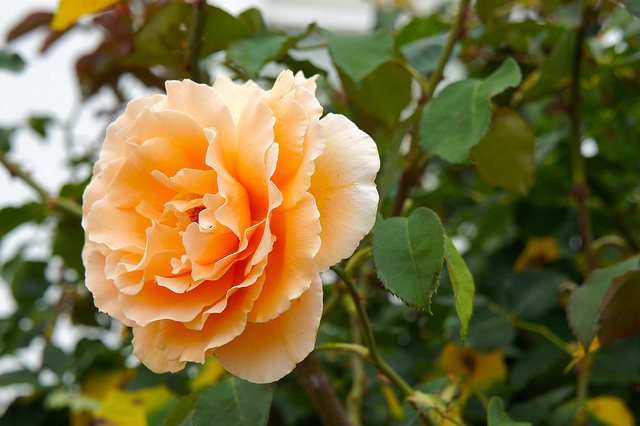

Remy Martin was crossed in 1995 in France. Terry rose petals (up to 35 pcs.), Have a pleasant apricot-orange color, although a saturation of yellow can be observed inside the bud. Flowers of a romantic form, there are both in the inflorescence and single. Repeated appearance. At the end of the bud opening, a nice pink blush may appear around the edges. Remy Martin is frost and disease resistant (powdery mildew, black spot). Has a beautiful fragrant aroma. Used in various group compositions.
John Franklin
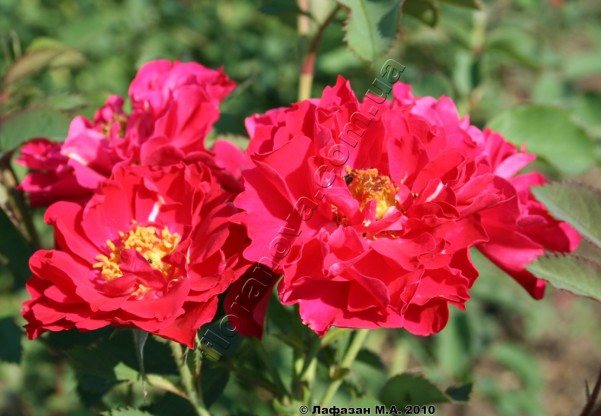

The well-known variety of the Canadian park rose was bred in 1980 and was named after the famous explorer John Franklin. The bush of this species is of small height 100-130 cm and 120 cm wide. Leaves are shiny, dark green, rounded. John Franklin has a slight odor. The repairing variety is resistant to frost and disease. The petals are pointed, semi-double (up to 25 pcs.), Bright red. The buds are collected in a brush (up to 30 pcs.), 5-6 cm in diameter. They are planted in a flower bed, in groups, but in general it is better to place the variety for landscaping a large area.
Martin Frobisher


Canadian park rose Explorer type bred in 1968. It is characterized by a vigorous bush 101-180 cm in height and 100 cm in width, with straight, almost thornless, graceful stems. Blooms profusely until frost. The petals are two-colored: fabulous milky pink on one side and pure white on the back. The petals are bent inward, where the saturation of the pink hue is observed. The buds are collected in inflorescences of 5 pcs., Up to 6 cm in diameter. Suitable for cutting, hedging, groups.
F. I. Grootendorst ("FJ Grootendorst") *


The bush is pyramidal in shape, somewhat widened. Height borders from 1-1.5 m. Leaves are shiny, dark green. The color of the flowers is red, collected in inflorescences, where there are 5 - 20 small, double pieces. The bud is clove-shaped. The aroma is present, but very weak. Plant in single, group plantings.
Fruhlingsduft


Reaches up to 2.5 m in height. The bush is erect, double petals, yellow-lemon color with a pink tint. Has a pleasant, aromatic scent. It blooms quite luxuriantly for up to 5 weeks. Freezing in winter is possible, so it is advisable to bend the shoots to the ground in autumn, under the snow they are like in a fur coat. Used in groups.
Maigold
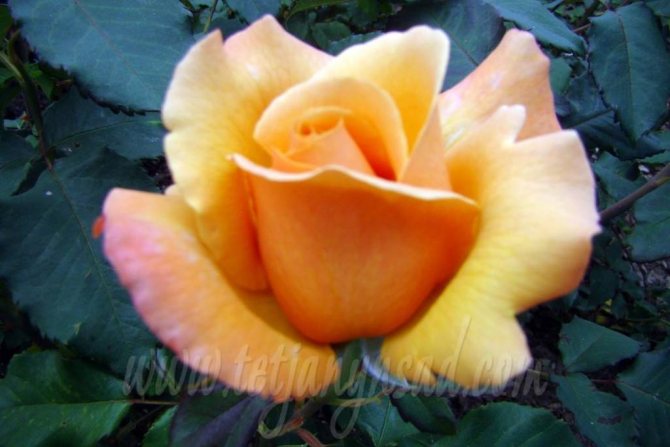

2.5 m high. Sprawling bush with dark green leaves. The buds are bronze, very large, but semi-double. The smell is intense. Abundant flowering lasts up to 5 weeks. In most cases it winters well, but bend the stem to preserve it in harsh winters. Used for fences, panels and wall decoration.
Parsley ("Parsla") *
The variety was mined in 1980. It has a pyramidal (up to 2 m in height) shape. Flowers - large, in inflorescences from 3 - 12 pcs., Have a bright white tint, semi-double petals. Good in the background.
Westland ("Westerland")
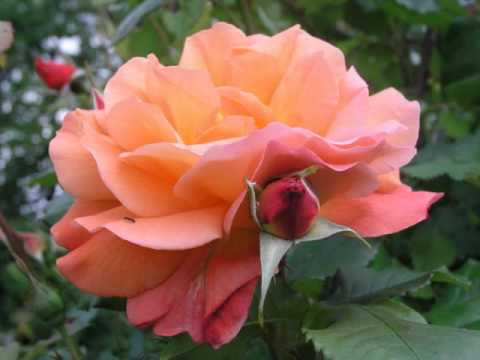

The Westland hybrid was obtained in 1969. The petals of the variety are orange-peach of an iridescent tone, because in the center you can see the saturation of yellow color, large (up to 12 cm in diameter), terry (up to 30 pcs.). The color may fade a little, so it can be planted in partial shade to make the color more saturated. Buds are collected in bunches of 5-10 pcs., Stable, placed on strong, straight and somewhat arcuate drooping shoots.
There is a strong smell, perceptible from afar. The "Westerland" bush reaches a height of 150-200 cm, and in volume - up to 150 cm, spreading, with light green stems with large thorns. Leaves are matte, glossy, considerable. Variety - remontant, blooms continuously from June and repeatedly from August to September. Winter-hardy look, for which the ADR Mark award, which is given to rose bushes for decorative qualities. Not bad in single and group landings.
Abraham Darby
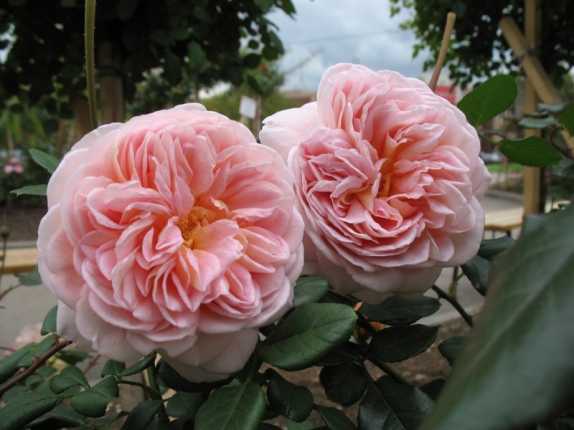

Crossed in 1985 by English breeder David Austin. The originator took as a basis a polyanthus yellow and climbing rose-red rose ("Yellow Cushion" and "Aloha"). Abraham Derby is a special species, extremely hardy, remontant. The petals are strongly double, bowl-shaped, large (when they open up to 10 cm), unusual color: inside - peach-apricot, outside - light yellow tones. The shade can fade to bright apricot in the heat, and the pink edges are restored in the cool.
Bloom is strong from June to September. The bush "Abraham Darby" is round, spreading, up to 200 cm in height and 100 - 150 cm in width. It has an average resistance to diseases (it can be affected by black spot). The leaves are shiny, leathery, dark green. Pleasant fruity aroma with notes of strawberry. Wonderful in groups, various combinations with pastel colors, ideal for the center of a flower bed, in the background and supported by a support such as a wall or fence.
Ferdinand Pichard


The world learned about Ferdinand Pichardo in 1921 from the French scientist Tannet. The bush is densely covered with shoots grow well upward, reaches a height of up to 150 cm and how much in volume. Blooms profusely and repeatedly from June to September. The smell of the plant is delicate and sweet, like nectarine. Leaves are light green, medium, glossy. The buds are striped, rounded, medium (5-10 cm in diameter), cupped, collected in small brushes. The petals are terry (up to 25 pcs.), The shade of which is carmine red with pink stripes that fade in the sun and become white, while the base, on the contrary, becomes more saturated, bright.
Perfect for groups and singles, in the center or in the background of a site.
Chinatown
The Chinatown rose bush is undemanding to the soil (it can grow in a soil poor in humus), has a good shape, up to 110 cm in height, with strong and thick branches (90 cm long). Leaves - dense, matte, dense, shiny. The buds are goblet-shaped, creamy yellow, large (up to 10 cm in diameter), with sharp edges, collected in inflorescences of 10 pcs., Less often, they are single. Terry petals (up to 50 pcs.). The color of the cup-shaped flowers fades over time and turns into a pale yellow with pink edges. The variety has a wonderful, strong aroma. Looks good in single and composite plantings in the rose garden.
John Davis


John Davis belongs to the Canadian park roses, very suitable for severe frosts (can easily survive winter with temperatures as low as -35 - 40 ° C). The species is resistant to disease. The bush reaches a height of 250 cm, has arched shoots slightly hanging down. Terry petals (up to 40 pcs.), Bright pink in the beginning, and then fade to pale pink with a creamy center. The buds are collected in inflorescences up to 15 pieces, 7-10 cm in diameter. Bloom continuously until frost. John Davis does not need to be pruned in the spring. Propagated, in addition to grafting, also by cuttings. Suitable for groups in a flowerbed.
Alexander MacKenzie
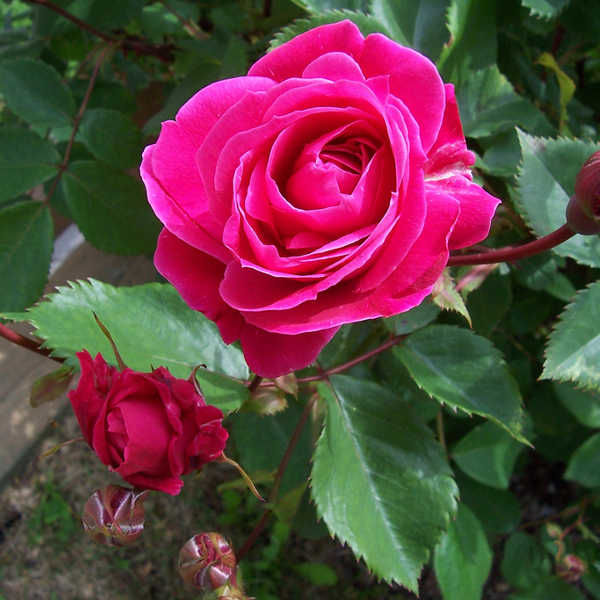

An exquisite erect, strong bush reaches a height of 200 cm and a volume of 130-150 cm. The Alexander Mackenzie variety was bred in 1985. Red petals, double (up to 45 pcs). The buds are collected in a brush of 5-11 pcs., When blooming, their diameter is 5-8 cm. The flowers are similar in shape to the hybrid tea type of roses. There is a light aroma. The variety is resistant to frost (withstands -30 - 45 ° C). Usage: in mixborder, groups.
Louise Odier
The unpretentious bush "Louise Odier" is marked by strong, straight, thin stems that have practically no thorns. Its height is 1.5 - 2 m. The leaves are light green, great. Abundant bloom, twice a season (June and August-September). It has medium-sized buds (6-10 cm in diameter), often double, collected in inflorescences of 3 pcs., Cup-shaped. Non-thick stems bend under the onslaught of flowers. A pleasant, rich lemon aroma subsequently turns into a luxurious pink scent. The color of the petals is pink-violet. Louis Audier is resistant to frost and winter. Often planted in a rose garden, lawns.
Concerto ("Concerto")
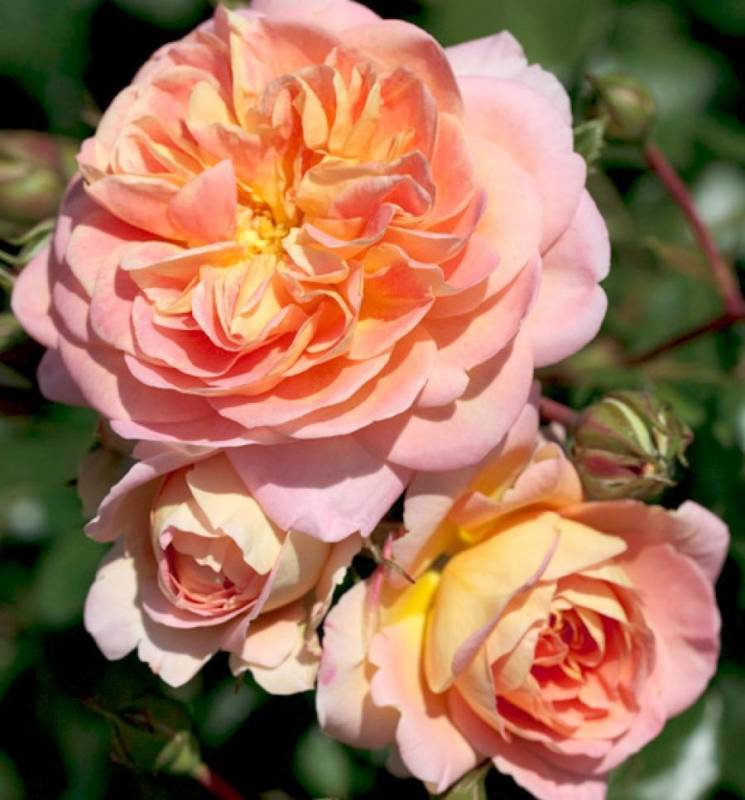

The Concerto variety was developed in 1994 in France. It is characterized by cupped, dull peach-yellow, large buds in brushes of 5-10 pcs. Corrugated petals, terry (80 pcs.), Rich apricot color in the center, well overlapping. Leaves are glossy, dark green. The variety blooms from June to September. The buds are so heavy that the shoots buckle. The bush is sprawling, 90-100 cm high, voluminous, so you should leave enough space for it to grow. This variety can be used to decorate a mixborder, a garden, planting them in groups.
Fluorescent ("Fluorescent")


The unique type of park roses Fluorescent has a strong, wide and tall (about 120 cm) bush of good shape. Terry petals, bright red, slightly bent outward. The leaves are dark green, dense, large, shiny. The bud is cup-shaped, mainly in inflorescences up to 5 pcs., Although it can be single, when blooming 7-8 cm in diameter. It blooms luxuriantly in 2 waves: in summer and early autumn. Resistant to frost and most diseases. It is advisable to plant on arches, wallpaper or other supports.
Rose multiflorous
It is a shrub - a plant with long climbing branches covered with paired thorns. The flowers are pink and white, odorless. Fruits are red, small, spherical in shape. The bush has a lush flowering, especially in sunny places.
For soils, like many species from the group, it is not demanding. It looks very decorative during the period of snow-white flowering and in autumn, when the bushes are strewn with red fruits that remain on them until next year.
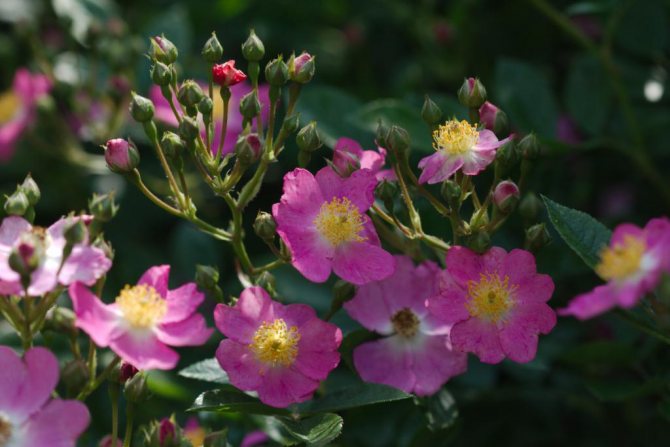

Description
Often a park rose is also called a cultivated rosehip: indeed, these plants are very similar. However, the rose has double petals, which gives its flowers more splendor in comparison with the rosehip.
The rose bush reaches a height of one and a half meters, and it grows strongly in width. Therefore, when planting, it is immediately necessary to allocate enough free space for the plant, taking into account future growth.
The shrub begins to bloom early and continues to bloom for 4-5 weeks. Rose flowers are very beautiful - double, lush, delicate, exuding a pleasant aroma. One such flower can have up to 150 petals (see photo).
As for the color of the petals, the palette in this case is very wide. A park rose can be any shade from white to red. Rare black, purple, rich orange varieties have also been bred.
In Europe, park roses do not cover for the winter, but in our climate it is desirable to do this. However, it is possible for Russia to pick up such varieties that do not require shelter.
Use in design
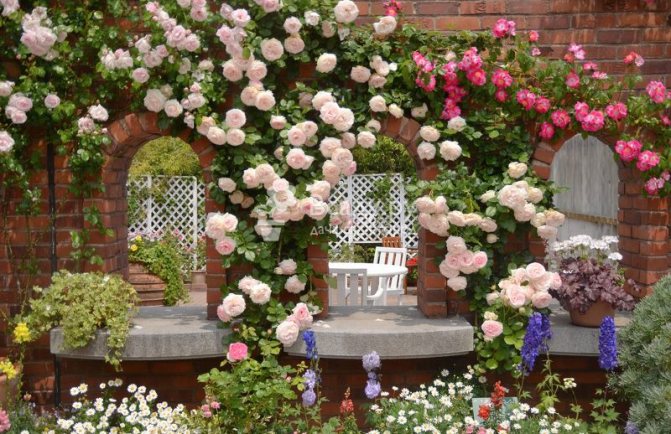

Park roses are great for decorating gardens, parks, city streets.Plants look great throughout the growing season, even when not in bloom.
Park roses can be mono-planted, as well as included in the composition, shading other plants with their beauty. This shrub looks great as a decoration for gazebos, arched openings, as the background of flower beds.
They are often used for landscaping streets, since they can grow even in conditions of strong gas pollution. You can use a tall shrub as a hedge element: both decoration and benefit.
In favorable conditions and with the necessary care, the park rose can easily live up to 25 years, annually pleasing with its flowers.
Care
Roses need to be fed in a timely manner, to which the queens will respond with gratitude in the form of a lush bloom. The procedure is performed in spring during bud formation and in summer during bud opening. In the fall, feeding is not needed, as it will provoke the growth of new shoots before frost, which is undesirable. At least once a week, the bushes are watered. If the summer turned out to be especially dry, then the frequency of the procedure should be at least doubled. Watering is carried out in the early morning or late evening, so that the roots of the rose in the heated soil are not "boiled" alive in boiling water. Loosening of the soil must also be carried out in a timely manner. The root system necessarily requires access to oxygen, which closes tightly compacted soil. Mulching the soil is possible, which will prevent the growth of weeds around the rose garden. Some varieties need to be covered for the winter. In the spring, diseased shoots are cut off so that it is easier for the plant to drive out strong shoots, and it does not waste juices on weak ones. Three times a season, flowers are sprayed with special formulations from pests and diseases.
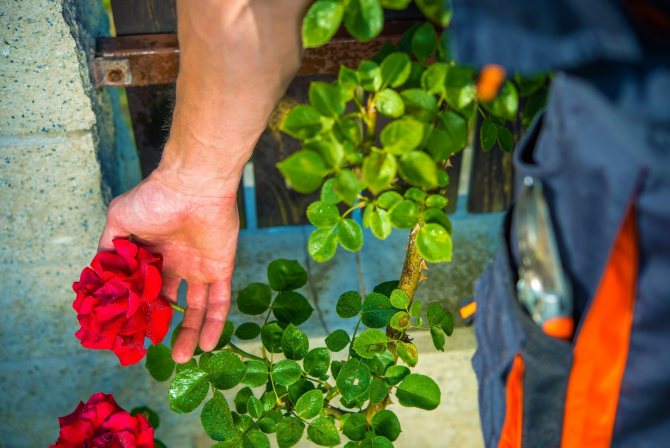

General information
It is park roses that are often used when decorating large summer cottages and park areas. Almost all varieties are frost-resistant, and their flowering occurs for quite a long time. Even in case of frostbite of the bush in cold winter, new young shoots appear from the root in spring, and the bush grows again.
Park roses of modern varieties bloom in the first half of summer, earlier than other groups, and bloom profusely for more than a month.
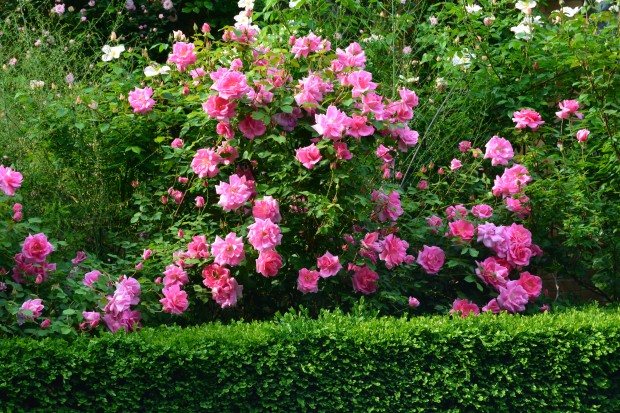

This group of roses includes old garden roses, which were cultivated with decorative rose hips (alba and rugosa rose), and more modern hybrids, which are winter-hardy varieties of selections in Canada and America.
It should be noted that there is some information that in the 19th century varieties of French, Damascus and Columbus roses were planted in Russian gardens. And most of them wintered well under a large snow cover without shelter.
Today, there are remontant varieties - with two flowering per season.
Planting flowers
Park roses can be planted individually or in groups. And you can form whole hedges from these flowers. Planting plants is not difficult, but it requires some additional work and adherence to the correct sequence of actions.
Optimal timing
These flowers grow outdoors, so they need to be planted in the warm season. You can start planting bushes from May and carry it out until mid-autumn.
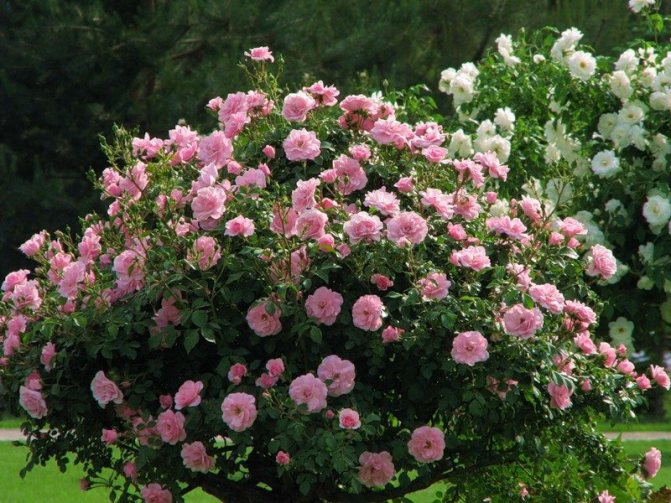

For good rooting and growth, it is better to plant plants in late September or even early October. In this case, they will have time to grow roots and will be stronger and more developed compared to flowers planted in spring.
Preparatory work
In order for the bushes to take root and take root better when planting on the site, you need to prepare the soil and the seedlings themselves.
Before planting plants, it is recommended to carry out several mandatory actions:
- a month before planting, dig up the soil on the site to a depth of about 60 cm;
- add mineral and organic fertilizers to the soil to enrich it with all the necessary nutrients;
- if it is impossible to immediately plant the seedlings, then their roots must be dipped in water or wrapped in a damp cloth to prevent them from drying out;
- 2 weeks before planting, dig holes in the soil with a diameter of 90 cm and a depth of about 70 cm. The recesses should be wide so that the straightened roots of the seedlings fit in them.
Gardeners also grow rose varieties such as:
Landing technology
After the plot and seedlings are prepared, you can proceed directly to planting flowers. This process is not difficult, but it requires some rules to be followed.
Step-by-step instructions for planting park roses are presented below:
- The distance between adjacent bushes in the same row should be 1–1.5 m, so that adult plants do not grow close to each other.
- The distance between rows of bushes should be at least 3 m.
- Mix the soil obtained by digging holes with manure.
- Pour a little of this mixture into each groove and pour well with water.
- Prune bruised and damaged roots of seedlings with pruning shears. Cut off the tips of the ground part of the shoots, leaving three eyes on each of them.
- Place the roots of the seedling in the hole, spread them out and sprinkle with soil. Tamp the soil around the plants well.
- Water the plants and spud them to a height of 20–25 cm.
- If planting is carried out in the fall, then mulch the soil around the bushes. Peat or chopped straw can be used as mulch.
Did you know? The oldest rose bush grows in the German town of Hildesheim near the cathedral. The plant is about 1000 years old.
If the bushes of plants are to form a hedge, then they are planted closer to each other. The distance between the rows is 50–70 cm, and between neighboring plants in the same row - up to 1 m.
Plant characteristics
Such plants usually grow up to 150 centimeters in height. Park plants bloom densely and for a long time - more than one month. The color of the flowers can vary from faded to bright shades, often orange or yellowish in color. Park specimens require a spacious area, since they grow very much in breadth. In warm countries, flowers do not need shelter, but in Russia, roses must be covered during frosts.
Flowers of this species have a significant advantage, which lies in their amazing endurance and undemanding care. This is due to the fact that the park flowers were bred on the basis of wild rose hips, which have been cultivated for a long time, and have passed selection selection. It is also worth noting that all these unique flowers are conventionally divided into two varieties: varieties with single and double flowering.
Characteristics
A general brief description of park roses is as follows: these are densely leafy and beautifully flowering shrubs, reaching a height of 150 centimeters, sometimes 200. The group earned this name for its magnificent landscape appearance. In favorable conditions, these plants form lush flowering bushes that bear fruit.
They are usually planted in groups, in combination with other plants or singly. In general, they are beautifully flowering shrubs, not inferior to mock orange or lilac. And in autumn, these bushes are attractive due to the bright colorful color of the leaves and ripe numerous fruits.
Flowers up to 7 cm in diameter have quite a few shades, and each has its own originality and beauty. There are flowers of white, red, pink, purple, orange and yellow colors. The bushes of this group begin to bloom 2-3 weeks earlier than other groups of roses. Most varieties have beautiful lush double flowers. The leaves have a light gray bloom.
Features of the climate of the Moscow region
The climate in the Moscow region is moderately continental. Continentality is better expressed in the eastern and southeastern regions. The seasons in the Moscow region have clear boundaries. So, winters are very cold and summers are warm.
The number of days in a year at which the average temperature does not exceed 0 ° C is from 120 to 135 days.January is especially frosty. This month the thermometer often drops to -30 ... -25 ° C. There was a case when the temperature dropped to -54 ° C (date not specified). The thickness of the snow cover here rarely exceeds 30-50 cm. And the soil freezes to a depth of 0.75 m.
Summers can be cool and humid or warm and dry. It depends on the impact on the region of cyclones and anticyclones. The temperature at this time of the year varies between + 15 ... + 30 ° C. Below +10 ° C and above +35 ° C, it is rare. Drought periods during the season can be followed by rainy periods.
Preparing roses for winter
Since the beginning of August, the application of nitrogen fertilizers to the soil is stopped, but just at this time it is necessary to carry out the first strengthening podwinny root feeding of roses, which consists of 25 g of superphosphate, 2.5 g of boric acid (or 3.5 g of borax) and 10 g of sulfate potassium dissolved in 10 liters of water. This amount of mortar should be enough for 4 m² of area.
But it is better, instead of root, to carry out foliar treatments of roses - to spray the bushes on the leaves with the same solutions, but in a concentration three times less than with root dressing.
From the beginning of autumn, they also stop loosening the soil under the bushes, so as not to provoke the growth of shoots from dormant buds, and from mid-September they pluck out all the buds that are smaller than a pea, and those that are larger in size are allowed to ripen and form fruits.
What is winter hardiness and how is it determined?
Winter hardiness is the properties of plants to withstand various environmental factors in the autumn-spring period. Winter hardiness includes some concepts: cold hardiness is a characteristic of the variety, which gives the ability to withstand low positive temperatures from +0 to + 10 ° C, frost resistance - determining the ability of plants not to die at low negative temperatures.
Winter hardiness is a trait responsible for the viability of a rose in areas with harsh climatic conditions, the ability to withstand a whole range of adverse conditions. Among them:
- sharp temperature drops;
- return frosts;
- icing;
- snow and wind load;
- long thaws;
- winter desiccation.
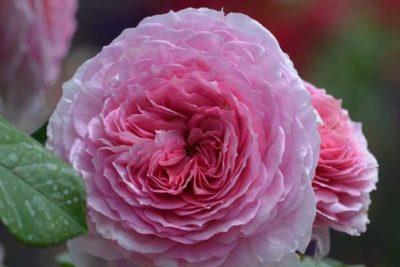

This indicator, first of all, depends on the genetic predisposition, but it can also change due to the conditions of the summer growing season.
Nice weather in summer:
- sufficient rainfall;
- optimal humidity;
- sunlight;
- warmth stimulates excellent growth and full development;
- and also affect the degree of color fastness.
When choosing a variety, it is advisable to focus on local types of roses, adapted to these climatic conditions.
Variety and varieties of roses
Roses differ in color, bud size, leaf shape and bushes height. Together with hybrids, the number of their varieties totals more than 3000. In landscape design, there is a single classification according to which plants are divided into three large groups:
- Evergreen bush. They are characterized by fast growth and a long flowering period. Evergreen shrubs include bourbon, polyanthus, hybrid tea, Bengal, tea and noisette roses.
- With leaves falling before winter. These include white, damask, centifol and French roses.
- Goethey (weaving). Climbing roses of this group have very poetic names: Ave Maria, Gloria Deya, Orange Elf, Concerte, Virgo.
An important characteristic for the queen of flowers is her doubleness, that is, the ability to increase the number of petals in one bud, in comparison with the wild-growing analogue. Based on this property, three types of plants are distinguished:
- Simple.
- Semi-double.
- Terry.
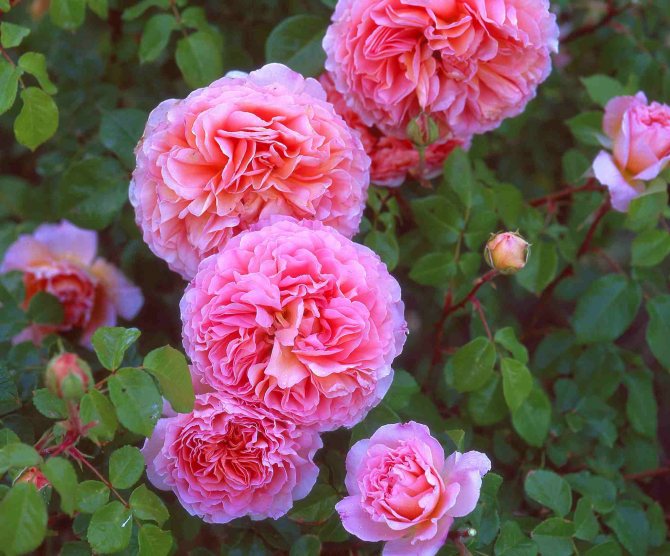

In the latter, the number of petals in one bud can be more than 150. Also, flowers are classified according to another characteristic - the height of the bushes:
- Curb.
- Medium-sized.
- Tall.
- Groundcover. In this group, weaving and undersized varieties are combined.
Roses vary in color.The color of the bud is perhaps the most important feature on which they rely in the first place when choosing. In addition to the four above-mentioned colors, roses can be burgundy, brown, orange, purple, purple, fuchsia. There are several dozen special varieties in which the petals have an unusual color from a combination of two shades and their halftones. Hybrids are of great importance in landscape design. Artificially bred varieties by crossing bring variety to garden areas, thanks to their unusual shape, special terry or extraordinary color.


Hybrids are classified into the following groups, which combine several dozen species:
- Floribunda roses. The group arose after crossing the tea and polyanthus varieties. It includes miniature curb roses and bushes, reaching a height of more than 1 meter. Floribunda is characterized by "bouquet" flowering, that is, its semi-double buds form lush brushes.
- Hybrid teahouses. They are distinguished by increased immunity to diseases, but are extremely sensitive to frost, therefore, the bushes are grown only in the south. This group includes all varieties that were bred on the basis of a tea rose. Their color palette starts with yellow and ends with pale orange.
- Rugosa hybrids. They were obtained after selection experiments with wrinkled rose hips. The main advantage of the variety is its frost resistance. Rugosa hybrids are unpretentious in care, varied in the degree of terry, and most often become the center of park compositions. There is no need to cover the plants for the winter.
- Hybrids of Grandiflora. Plants are erect, visually reminiscent of a tea variety, but with abundant bouquet flowering, like Floribunda. The varieties are not afraid of frost and bloom for a long time.
- Polyanthus. They are the result of crossing Chinese and multi-flowered roses. The bushes have small buds, collected in "brushes". They bloom for a very long time until the first frost, which, by the way, is also not afraid. Due to their diminutive size, polyanthus roses are often used to decorate window sills in potted homes.
- Shrubs. A special group that includes weaving and undersized varieties.
- Miniature. They vaguely resemble polyanthus, but their height does not exceed half a meter. They are grown both outdoors and in pots. Bloom for a long time until the first frost.
- Climbing. They are unofficially called the “queens” of landscape design. The bushes are distinguished by their impressive height, which is why they need artificial supports. Easily get the desired shape after a haircut, unpretentious in care. They can have simple buds and double buds.
- Patio. They are similar to miniature ones, as they grow poorly, but their tiny buds are collected in fluffy bouquets. Often used to create design compositions on the landscape of personal plots. Look great in single lawns, border flower beds along the edges of garden paths and in individual hanging pots-pots on the street.
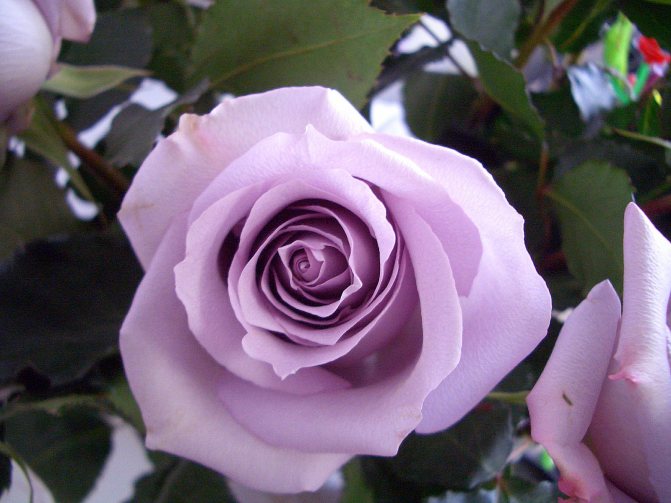

As can be seen from the classification, the queen of flowers can have many guises and each variety has its own characteristics. It will be quite difficult for fans to cope with a capricious "lady" in the garden, but floriculture lends itself to stubborn ones.
Thanks to the rich "assortment" of roses, they can be selected both for the mild southern climate and for the harsh winters of Siberia, and the exuberantly blooming garden will become a source of pride for the owners and the envy of neighbors.
Views
The most resilient
Siberia is famous for its harsh climate. Not all plants can withstand such weather conditions: in winter the air temperature is up to -50 ° С, in summer up to + 30 ° С. Flowers, and even more so heat-loving roses, simply do not survive there.
However, nothing is impossible, varieties have been bred that can grow and develop excellently even in such a difficult climate.
Black magic
One of the most popular frost-resistant varieties of German breeders. Suitable for cutting. Can stand in a vase for more than three weeks.It is mainly produced for sale, but residents of colder regions use this variety to decorate their flower beds.
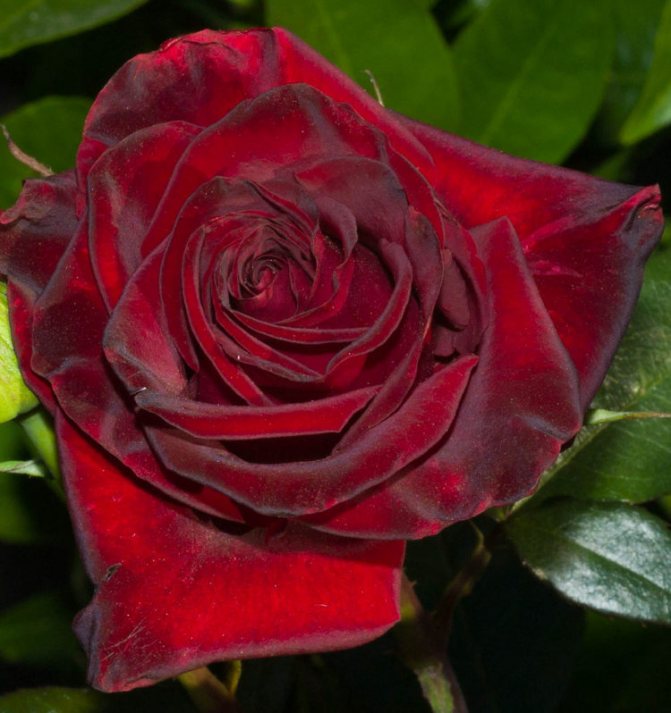

For more information about this variety, see the video below:
Rosarium Uetersen
The flowers are dark red with light, sun-fading edges. It is characterized by cyclical flowering, the first time - quite abundantly. Resistant to disease and cold.


About the most unpretentious roses Rosarium Utersen in the video below:
Chippendale
Perfect for growing in continental conditions. The variety is loved by summer residents of the Moscow region. It tolerates both heat and cold well.
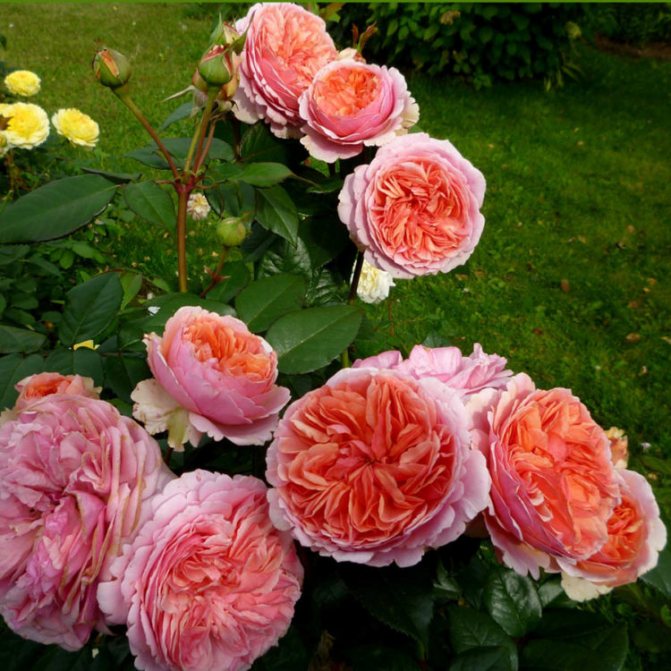

Rose bush Chippendale - more in the video below:
Everything about bush roses is described here.
Robusta
Frost-resistant flower. The colors are varied, so you can make a bright composition. A feature of this variety is the ability to recover from a slight hypothermia.
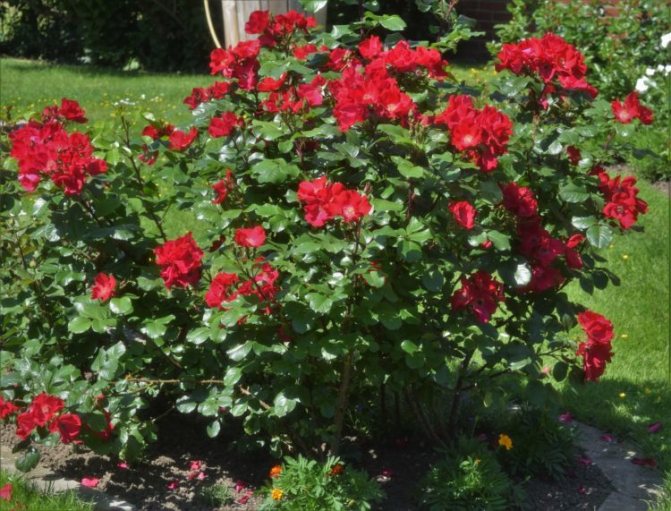

Rosa Robusta: unpretentious scarlet beauty - more in the video below:
Only a little cold is tolerated
The following varieties are moderately hardy, which do not freeze to the level of snow in a cold winter, but plants recover with the arrival of heat. These varieties include:
- Golden Wings;
- Lichtkonigin Lucia;
- Captain Samuel Holland;
- Westerland;
- Quadra.
Blooming all summer
New dawn
A fragrant rose that blooms all season and practically does not get sick.
New Dawn rose-intelligent - more in the video below:
Amadeus
A climbing rose that is most resistant to various diseases.
Florentina
Shrub up to 2 meters high. Blooms from June to September.


Rhapsody in blue
The color ranges from dark lilac to light purple. It has a lush, long-lasting flowering. It tolerates the rainy season well, and is also not susceptible to fungal diseases.
Bush rose Rhapsody in Blue - a brief overview and description of the characteristics in the video below:
Unpretentious
Rugosa
The variety was bred from wrinkled rose hips. Flowers are unpretentious. They are not afraid of dusty air, pollution. This variety is often planted along roads. Garden roses rarely get sick, which makes them stand out among other brethren.
Rose wrinkled - more in the video below:
Pink grootendorst
Variety with bright pink buds combined together. Winter-hardy, tolerates pruning at any height.
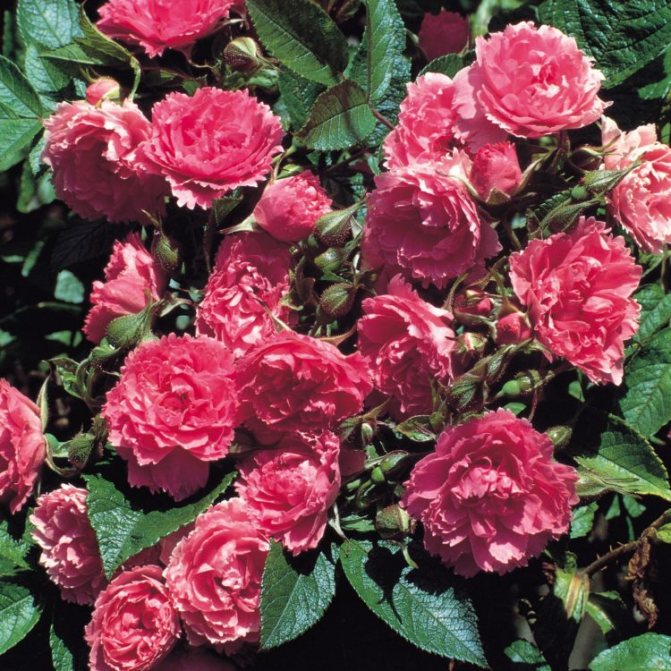

For more information about the Pink Grutendorst park rose, see the video below:
Martin frobisher
Roses are bred in Canada. They are characterized by resistance to frost. They tolerate cold and heat well. The height of the bush is up to 180 cm.
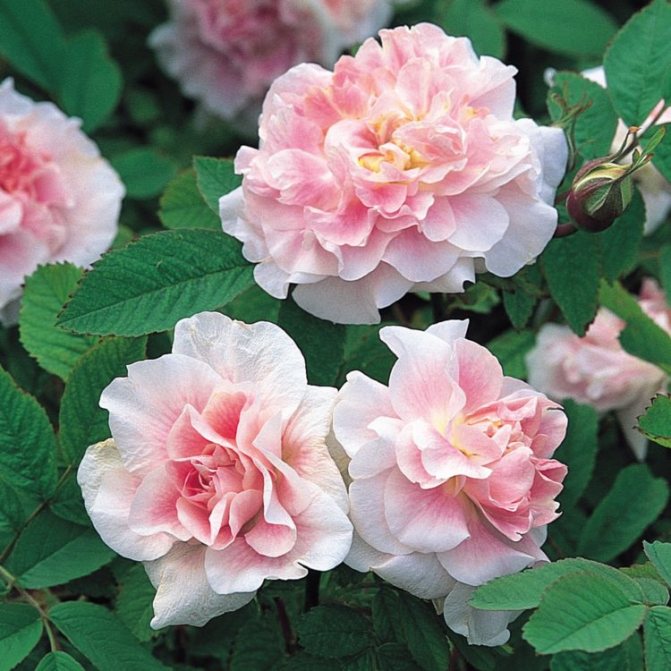

Review of Rose Canadian Park by Martin Frobisher in the video below:
Read about the best winter-hardy Canadian rose varieties here.
Therese bugnet
It took breeders 25 long years to get this variety. But now it is in great demand, because it is unpretentious and frost-resistant, and also has practically no thorns.


Wintering
Although park roses are frost resistant, winter preparation is an important part of grooming. It is especially important for young plants up to 3 years old. To do this, after flowering, all the buds and leaves are removed, and then the soil is piled up along the entire diameter to a depth of 30 cm.
It is necessary to mulch the ground, which will save the roots from hypothermia. The stems are tied tightly to a support and then wrapped in craft paper or cotton cloth. When grown in the north, it is advisable to additionally use spruce branches or agrofibre.
Flowering period
As already stated, winter hardiness is a characteristic of various types of roses. And the start time and duration of flowering depends on a particular subspecies.
- Hybrid tea varieties bloom in several stages, starting from May until the cold weather (read about the history of origin and the peculiarities of growing such varieties of roses here, and the hybrid tea variety Ashram is described here).
- Park roses usually bloom in the summer, around the end of May - June.
- Climbing can be pleasing to the eye from spring to autumn, but some varieties bloom once in early summer.
- Ground blooms bloom magnificently at the end of May, and the process lasts until the very frost.


